Strategic Analysis of Wyndham Resorts and Hyatt Hotels: MAN707
VerifiedAdded on 2022/09/18
|7
|1684
|21
Report
AI Summary
This report provides a comparative strategic analysis of Wyndham Resorts and Grand Hyatt, Melbourne. It examines the mission, vision, and values of both companies, highlighting their differing approaches to marketing and hospitality. The analysis employs the PESTEL framework to assess macro-environmental factors, including political, economic, social, technological, environmental, and legal aspects, and Porter's Five Forces to evaluate competitive dynamics. The report contrasts the strategies of Ramada Resorts (Wyndham) and Grand Hyatt, emphasizing Wyndham's adaptive and effective approach, particularly in its ability to compete in new markets and manage market forces effectively. The conclusion favors Ramada Resorts' strategy as more successful due to its adaptability and market control.
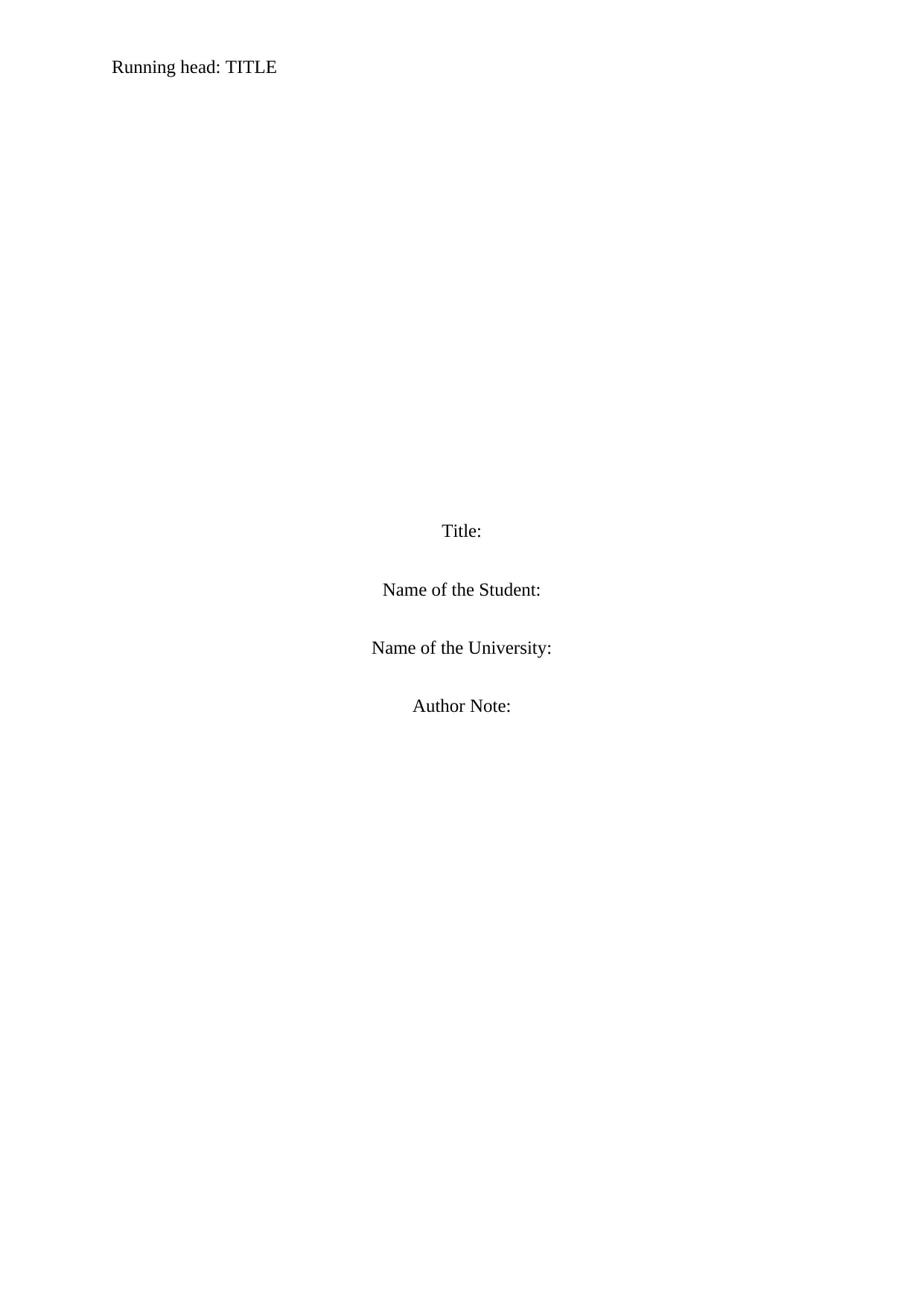
Running head: TITLE
Title:
Name of the Student:
Name of the University:
Author Note:
Title:
Name of the Student:
Name of the University:
Author Note:
Paraphrase This Document
Need a fresh take? Get an instant paraphrase of this document with our AI Paraphraser
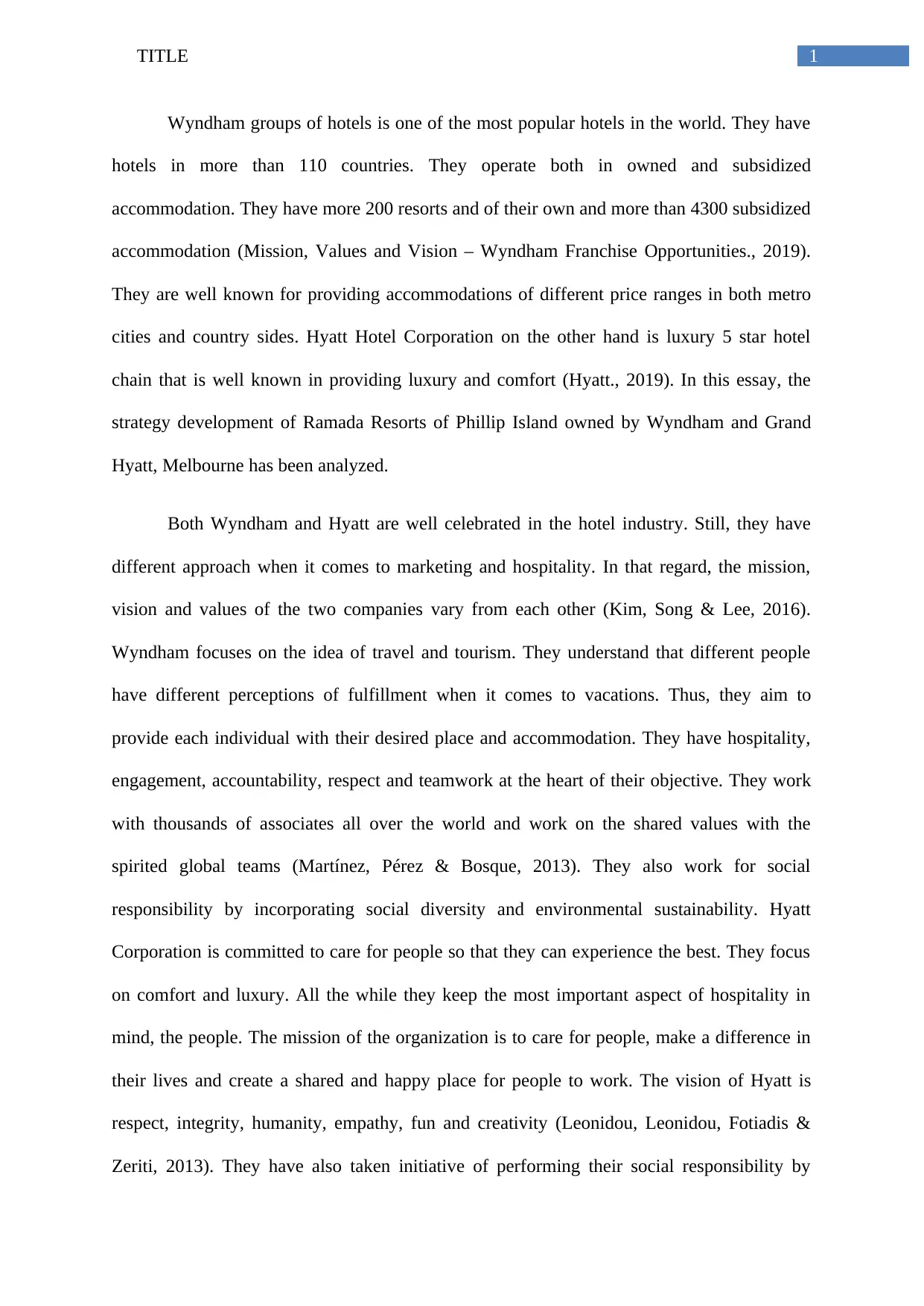
1TITLE
Wyndham groups of hotels is one of the most popular hotels in the world. They have
hotels in more than 110 countries. They operate both in owned and subsidized
accommodation. They have more 200 resorts and of their own and more than 4300 subsidized
accommodation (Mission, Values and Vision – Wyndham Franchise Opportunities., 2019).
They are well known for providing accommodations of different price ranges in both metro
cities and country sides. Hyatt Hotel Corporation on the other hand is luxury 5 star hotel
chain that is well known in providing luxury and comfort (Hyatt., 2019). In this essay, the
strategy development of Ramada Resorts of Phillip Island owned by Wyndham and Grand
Hyatt, Melbourne has been analyzed.
Both Wyndham and Hyatt are well celebrated in the hotel industry. Still, they have
different approach when it comes to marketing and hospitality. In that regard, the mission,
vision and values of the two companies vary from each other (Kim, Song & Lee, 2016).
Wyndham focuses on the idea of travel and tourism. They understand that different people
have different perceptions of fulfillment when it comes to vacations. Thus, they aim to
provide each individual with their desired place and accommodation. They have hospitality,
engagement, accountability, respect and teamwork at the heart of their objective. They work
with thousands of associates all over the world and work on the shared values with the
spirited global teams (Martínez, Pérez & Bosque, 2013). They also work for social
responsibility by incorporating social diversity and environmental sustainability. Hyatt
Corporation is committed to care for people so that they can experience the best. They focus
on comfort and luxury. All the while they keep the most important aspect of hospitality in
mind, the people. The mission of the organization is to care for people, make a difference in
their lives and create a shared and happy place for people to work. The vision of Hyatt is
respect, integrity, humanity, empathy, fun and creativity (Leonidou, Leonidou, Fotiadis &
Zeriti, 2013). They have also taken initiative of performing their social responsibility by
Wyndham groups of hotels is one of the most popular hotels in the world. They have
hotels in more than 110 countries. They operate both in owned and subsidized
accommodation. They have more 200 resorts and of their own and more than 4300 subsidized
accommodation (Mission, Values and Vision – Wyndham Franchise Opportunities., 2019).
They are well known for providing accommodations of different price ranges in both metro
cities and country sides. Hyatt Hotel Corporation on the other hand is luxury 5 star hotel
chain that is well known in providing luxury and comfort (Hyatt., 2019). In this essay, the
strategy development of Ramada Resorts of Phillip Island owned by Wyndham and Grand
Hyatt, Melbourne has been analyzed.
Both Wyndham and Hyatt are well celebrated in the hotel industry. Still, they have
different approach when it comes to marketing and hospitality. In that regard, the mission,
vision and values of the two companies vary from each other (Kim, Song & Lee, 2016).
Wyndham focuses on the idea of travel and tourism. They understand that different people
have different perceptions of fulfillment when it comes to vacations. Thus, they aim to
provide each individual with their desired place and accommodation. They have hospitality,
engagement, accountability, respect and teamwork at the heart of their objective. They work
with thousands of associates all over the world and work on the shared values with the
spirited global teams (Martínez, Pérez & Bosque, 2013). They also work for social
responsibility by incorporating social diversity and environmental sustainability. Hyatt
Corporation is committed to care for people so that they can experience the best. They focus
on comfort and luxury. All the while they keep the most important aspect of hospitality in
mind, the people. The mission of the organization is to care for people, make a difference in
their lives and create a shared and happy place for people to work. The vision of Hyatt is
respect, integrity, humanity, empathy, fun and creativity (Leonidou, Leonidou, Fotiadis &
Zeriti, 2013). They have also taken initiative of performing their social responsibility by
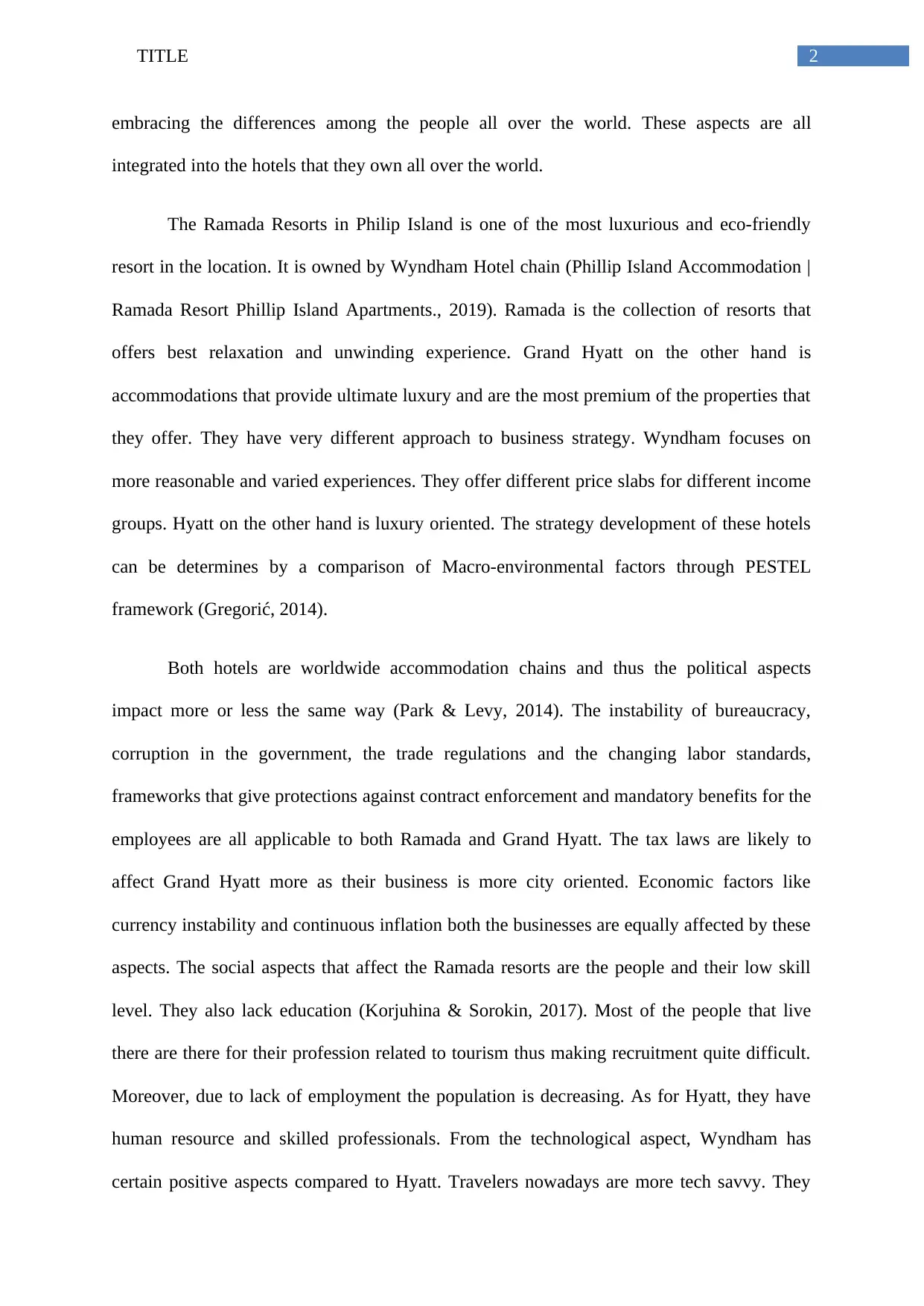
2TITLE
embracing the differences among the people all over the world. These aspects are all
integrated into the hotels that they own all over the world.
The Ramada Resorts in Philip Island is one of the most luxurious and eco-friendly
resort in the location. It is owned by Wyndham Hotel chain (Phillip Island Accommodation |
Ramada Resort Phillip Island Apartments., 2019). Ramada is the collection of resorts that
offers best relaxation and unwinding experience. Grand Hyatt on the other hand is
accommodations that provide ultimate luxury and are the most premium of the properties that
they offer. They have very different approach to business strategy. Wyndham focuses on
more reasonable and varied experiences. They offer different price slabs for different income
groups. Hyatt on the other hand is luxury oriented. The strategy development of these hotels
can be determines by a comparison of Macro-environmental factors through PESTEL
framework (Gregorić, 2014).
Both hotels are worldwide accommodation chains and thus the political aspects
impact more or less the same way (Park & Levy, 2014). The instability of bureaucracy,
corruption in the government, the trade regulations and the changing labor standards,
frameworks that give protections against contract enforcement and mandatory benefits for the
employees are all applicable to both Ramada and Grand Hyatt. The tax laws are likely to
affect Grand Hyatt more as their business is more city oriented. Economic factors like
currency instability and continuous inflation both the businesses are equally affected by these
aspects. The social aspects that affect the Ramada resorts are the people and their low skill
level. They also lack education (Korjuhina & Sorokin, 2017). Most of the people that live
there are there for their profession related to tourism thus making recruitment quite difficult.
Moreover, due to lack of employment the population is decreasing. As for Hyatt, they have
human resource and skilled professionals. From the technological aspect, Wyndham has
certain positive aspects compared to Hyatt. Travelers nowadays are more tech savvy. They
embracing the differences among the people all over the world. These aspects are all
integrated into the hotels that they own all over the world.
The Ramada Resorts in Philip Island is one of the most luxurious and eco-friendly
resort in the location. It is owned by Wyndham Hotel chain (Phillip Island Accommodation |
Ramada Resort Phillip Island Apartments., 2019). Ramada is the collection of resorts that
offers best relaxation and unwinding experience. Grand Hyatt on the other hand is
accommodations that provide ultimate luxury and are the most premium of the properties that
they offer. They have very different approach to business strategy. Wyndham focuses on
more reasonable and varied experiences. They offer different price slabs for different income
groups. Hyatt on the other hand is luxury oriented. The strategy development of these hotels
can be determines by a comparison of Macro-environmental factors through PESTEL
framework (Gregorić, 2014).
Both hotels are worldwide accommodation chains and thus the political aspects
impact more or less the same way (Park & Levy, 2014). The instability of bureaucracy,
corruption in the government, the trade regulations and the changing labor standards,
frameworks that give protections against contract enforcement and mandatory benefits for the
employees are all applicable to both Ramada and Grand Hyatt. The tax laws are likely to
affect Grand Hyatt more as their business is more city oriented. Economic factors like
currency instability and continuous inflation both the businesses are equally affected by these
aspects. The social aspects that affect the Ramada resorts are the people and their low skill
level. They also lack education (Korjuhina & Sorokin, 2017). Most of the people that live
there are there for their profession related to tourism thus making recruitment quite difficult.
Moreover, due to lack of employment the population is decreasing. As for Hyatt, they have
human resource and skilled professionals. From the technological aspect, Wyndham has
certain positive aspects compared to Hyatt. Travelers nowadays are more tech savvy. They
⊘ This is a preview!⊘
Do you want full access?
Subscribe today to unlock all pages.

Trusted by 1+ million students worldwide
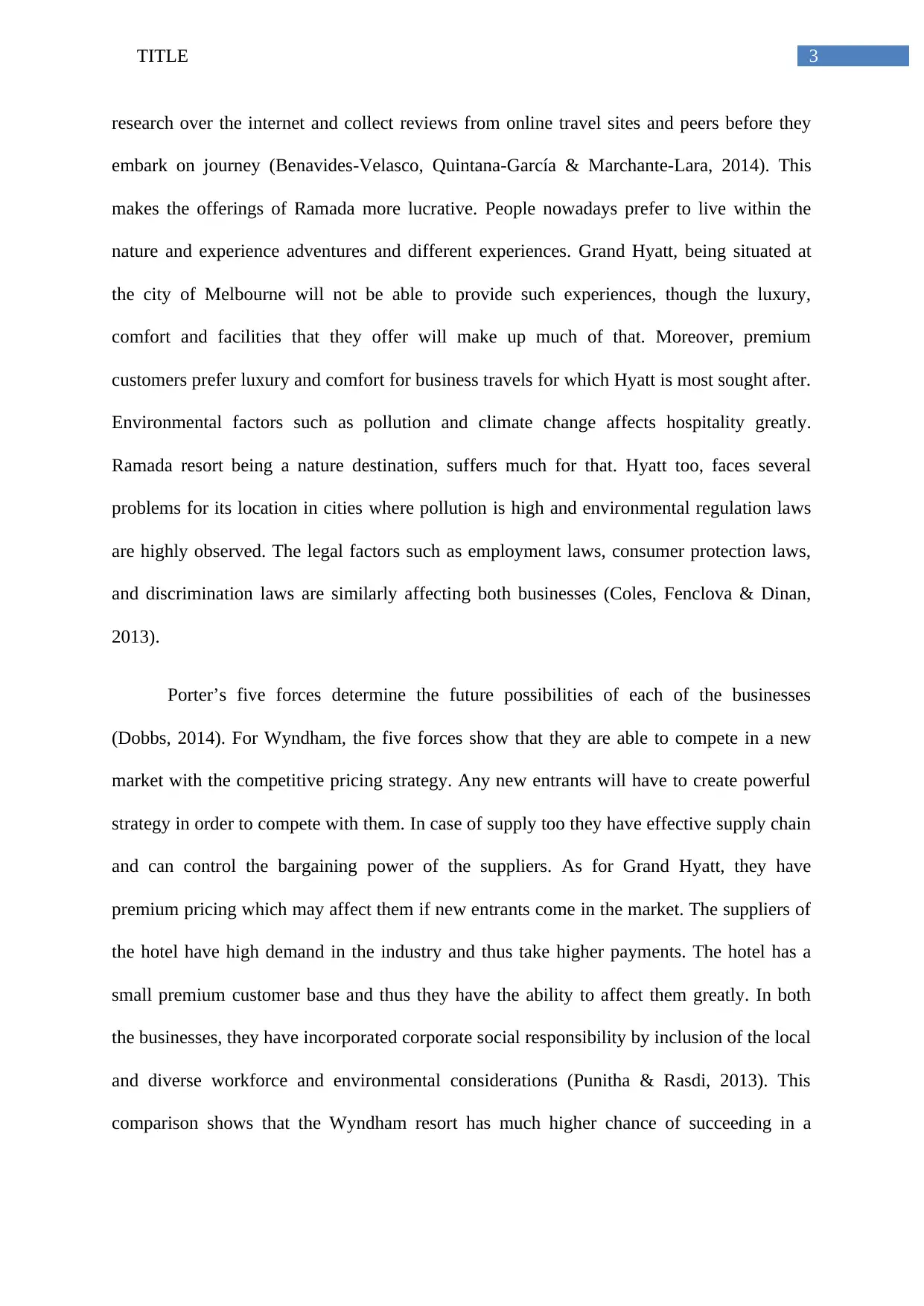
3TITLE
research over the internet and collect reviews from online travel sites and peers before they
embark on journey (Benavides-Velasco, Quintana-García & Marchante-Lara, 2014). This
makes the offerings of Ramada more lucrative. People nowadays prefer to live within the
nature and experience adventures and different experiences. Grand Hyatt, being situated at
the city of Melbourne will not be able to provide such experiences, though the luxury,
comfort and facilities that they offer will make up much of that. Moreover, premium
customers prefer luxury and comfort for business travels for which Hyatt is most sought after.
Environmental factors such as pollution and climate change affects hospitality greatly.
Ramada resort being a nature destination, suffers much for that. Hyatt too, faces several
problems for its location in cities where pollution is high and environmental regulation laws
are highly observed. The legal factors such as employment laws, consumer protection laws,
and discrimination laws are similarly affecting both businesses (Coles, Fenclova & Dinan,
2013).
Porter’s five forces determine the future possibilities of each of the businesses
(Dobbs, 2014). For Wyndham, the five forces show that they are able to compete in a new
market with the competitive pricing strategy. Any new entrants will have to create powerful
strategy in order to compete with them. In case of supply too they have effective supply chain
and can control the bargaining power of the suppliers. As for Grand Hyatt, they have
premium pricing which may affect them if new entrants come in the market. The suppliers of
the hotel have high demand in the industry and thus take higher payments. The hotel has a
small premium customer base and thus they have the ability to affect them greatly. In both
the businesses, they have incorporated corporate social responsibility by inclusion of the local
and diverse workforce and environmental considerations (Punitha & Rasdi, 2013). This
comparison shows that the Wyndham resort has much higher chance of succeeding in a
research over the internet and collect reviews from online travel sites and peers before they
embark on journey (Benavides-Velasco, Quintana-García & Marchante-Lara, 2014). This
makes the offerings of Ramada more lucrative. People nowadays prefer to live within the
nature and experience adventures and different experiences. Grand Hyatt, being situated at
the city of Melbourne will not be able to provide such experiences, though the luxury,
comfort and facilities that they offer will make up much of that. Moreover, premium
customers prefer luxury and comfort for business travels for which Hyatt is most sought after.
Environmental factors such as pollution and climate change affects hospitality greatly.
Ramada resort being a nature destination, suffers much for that. Hyatt too, faces several
problems for its location in cities where pollution is high and environmental regulation laws
are highly observed. The legal factors such as employment laws, consumer protection laws,
and discrimination laws are similarly affecting both businesses (Coles, Fenclova & Dinan,
2013).
Porter’s five forces determine the future possibilities of each of the businesses
(Dobbs, 2014). For Wyndham, the five forces show that they are able to compete in a new
market with the competitive pricing strategy. Any new entrants will have to create powerful
strategy in order to compete with them. In case of supply too they have effective supply chain
and can control the bargaining power of the suppliers. As for Grand Hyatt, they have
premium pricing which may affect them if new entrants come in the market. The suppliers of
the hotel have high demand in the industry and thus take higher payments. The hotel has a
small premium customer base and thus they have the ability to affect them greatly. In both
the businesses, they have incorporated corporate social responsibility by inclusion of the local
and diverse workforce and environmental considerations (Punitha & Rasdi, 2013). This
comparison shows that the Wyndham resort has much higher chance of succeeding in a
Paraphrase This Document
Need a fresh take? Get an instant paraphrase of this document with our AI Paraphraser
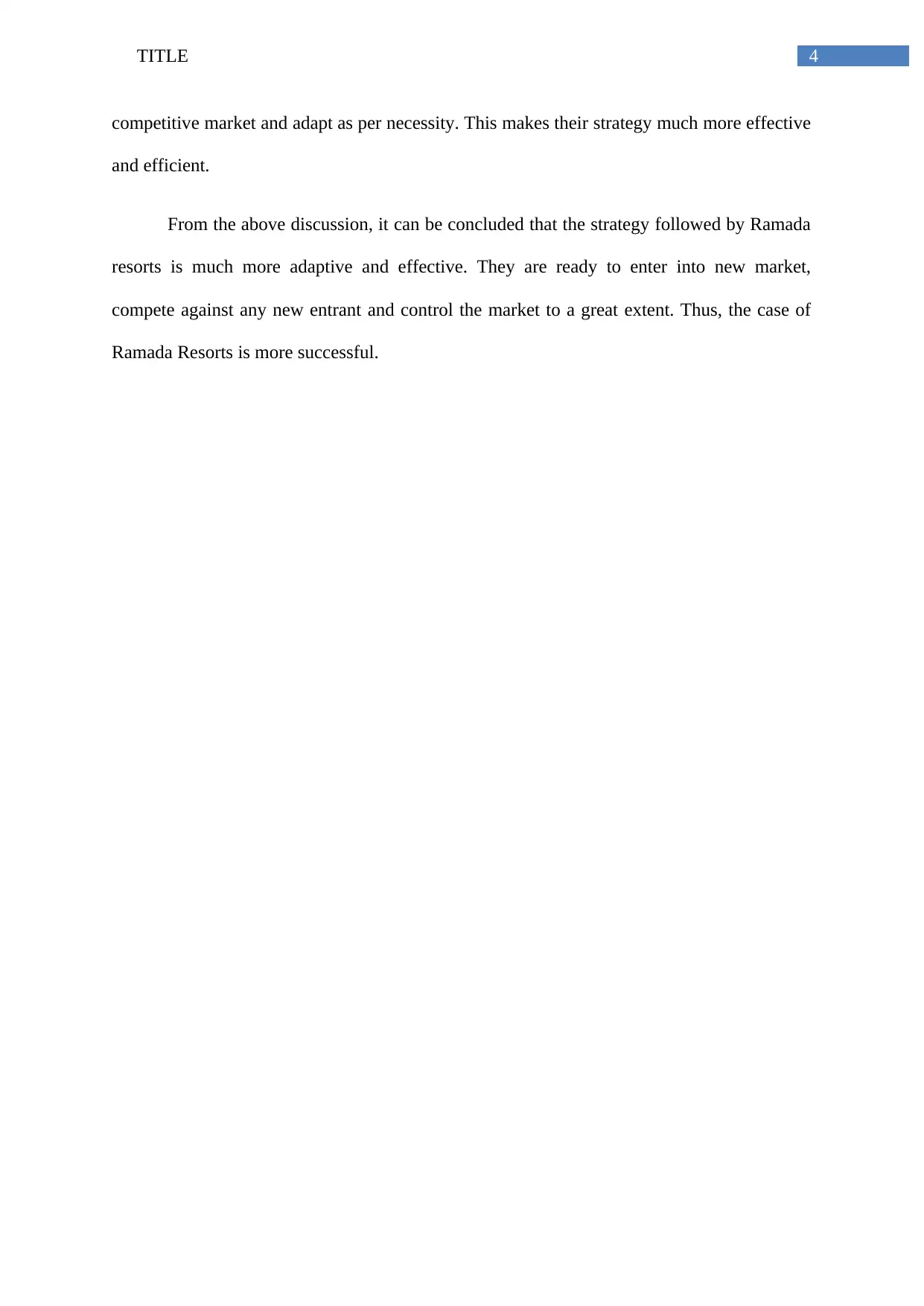
4TITLE
competitive market and adapt as per necessity. This makes their strategy much more effective
and efficient.
From the above discussion, it can be concluded that the strategy followed by Ramada
resorts is much more adaptive and effective. They are ready to enter into new market,
compete against any new entrant and control the market to a great extent. Thus, the case of
Ramada Resorts is more successful.
competitive market and adapt as per necessity. This makes their strategy much more effective
and efficient.
From the above discussion, it can be concluded that the strategy followed by Ramada
resorts is much more adaptive and effective. They are ready to enter into new market,
compete against any new entrant and control the market to a great extent. Thus, the case of
Ramada Resorts is more successful.
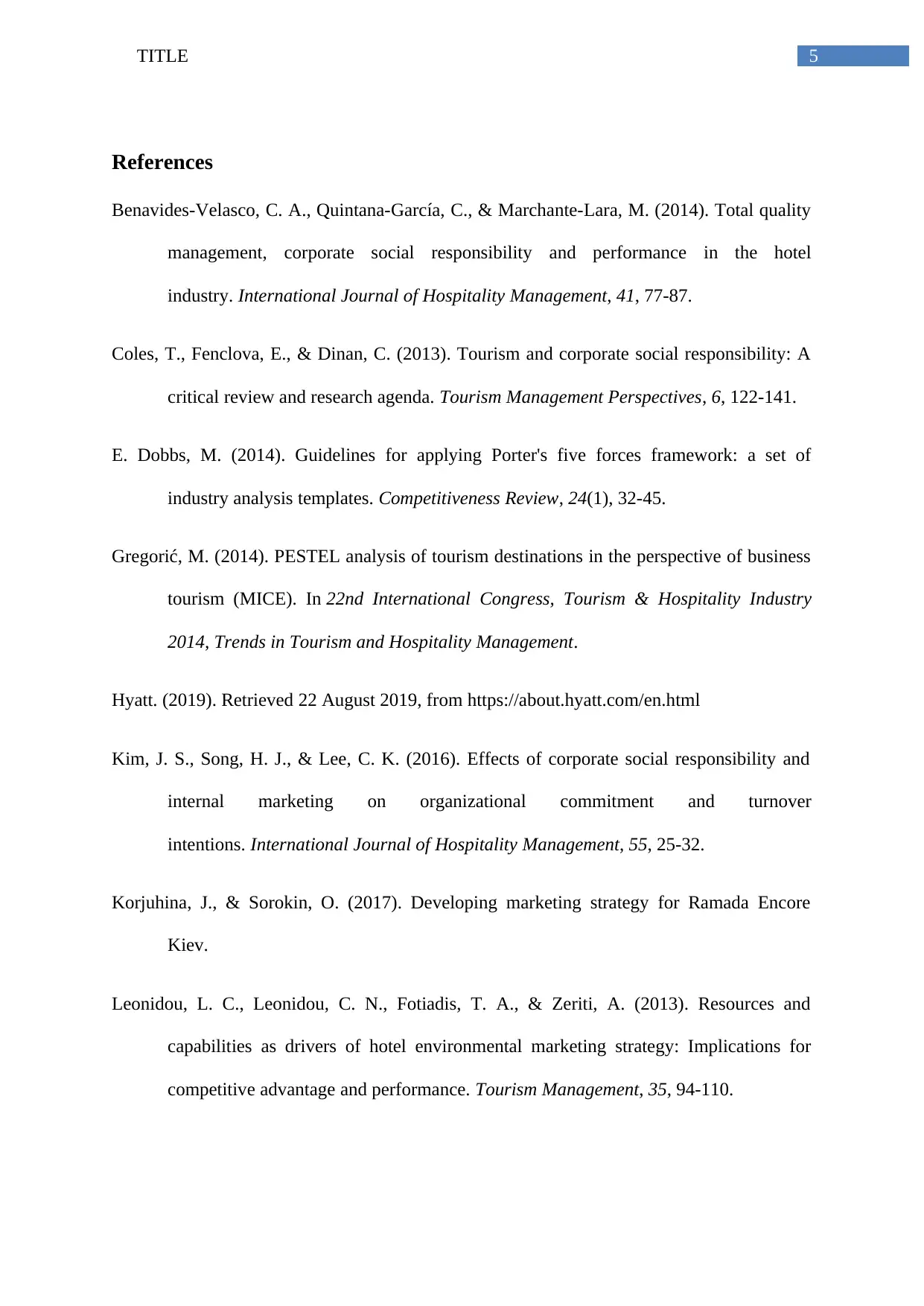
5TITLE
References
Benavides-Velasco, C. A., Quintana-García, C., & Marchante-Lara, M. (2014). Total quality
management, corporate social responsibility and performance in the hotel
industry. International Journal of Hospitality Management, 41, 77-87.
Coles, T., Fenclova, E., & Dinan, C. (2013). Tourism and corporate social responsibility: A
critical review and research agenda. Tourism Management Perspectives, 6, 122-141.
E. Dobbs, M. (2014). Guidelines for applying Porter's five forces framework: a set of
industry analysis templates. Competitiveness Review, 24(1), 32-45.
Gregorić, M. (2014). PESTEL analysis of tourism destinations in the perspective of business
tourism (MICE). In 22nd International Congress, Tourism & Hospitality Industry
2014, Trends in Tourism and Hospitality Management.
Hyatt. (2019). Retrieved 22 August 2019, from https://about.hyatt.com/en.html
Kim, J. S., Song, H. J., & Lee, C. K. (2016). Effects of corporate social responsibility and
internal marketing on organizational commitment and turnover
intentions. International Journal of Hospitality Management, 55, 25-32.
Korjuhina, J., & Sorokin, O. (2017). Developing marketing strategy for Ramada Encore
Kiev.
Leonidou, L. C., Leonidou, C. N., Fotiadis, T. A., & Zeriti, A. (2013). Resources and
capabilities as drivers of hotel environmental marketing strategy: Implications for
competitive advantage and performance. Tourism Management, 35, 94-110.
References
Benavides-Velasco, C. A., Quintana-García, C., & Marchante-Lara, M. (2014). Total quality
management, corporate social responsibility and performance in the hotel
industry. International Journal of Hospitality Management, 41, 77-87.
Coles, T., Fenclova, E., & Dinan, C. (2013). Tourism and corporate social responsibility: A
critical review and research agenda. Tourism Management Perspectives, 6, 122-141.
E. Dobbs, M. (2014). Guidelines for applying Porter's five forces framework: a set of
industry analysis templates. Competitiveness Review, 24(1), 32-45.
Gregorić, M. (2014). PESTEL analysis of tourism destinations in the perspective of business
tourism (MICE). In 22nd International Congress, Tourism & Hospitality Industry
2014, Trends in Tourism and Hospitality Management.
Hyatt. (2019). Retrieved 22 August 2019, from https://about.hyatt.com/en.html
Kim, J. S., Song, H. J., & Lee, C. K. (2016). Effects of corporate social responsibility and
internal marketing on organizational commitment and turnover
intentions. International Journal of Hospitality Management, 55, 25-32.
Korjuhina, J., & Sorokin, O. (2017). Developing marketing strategy for Ramada Encore
Kiev.
Leonidou, L. C., Leonidou, C. N., Fotiadis, T. A., & Zeriti, A. (2013). Resources and
capabilities as drivers of hotel environmental marketing strategy: Implications for
competitive advantage and performance. Tourism Management, 35, 94-110.
⊘ This is a preview!⊘
Do you want full access?
Subscribe today to unlock all pages.

Trusted by 1+ million students worldwide
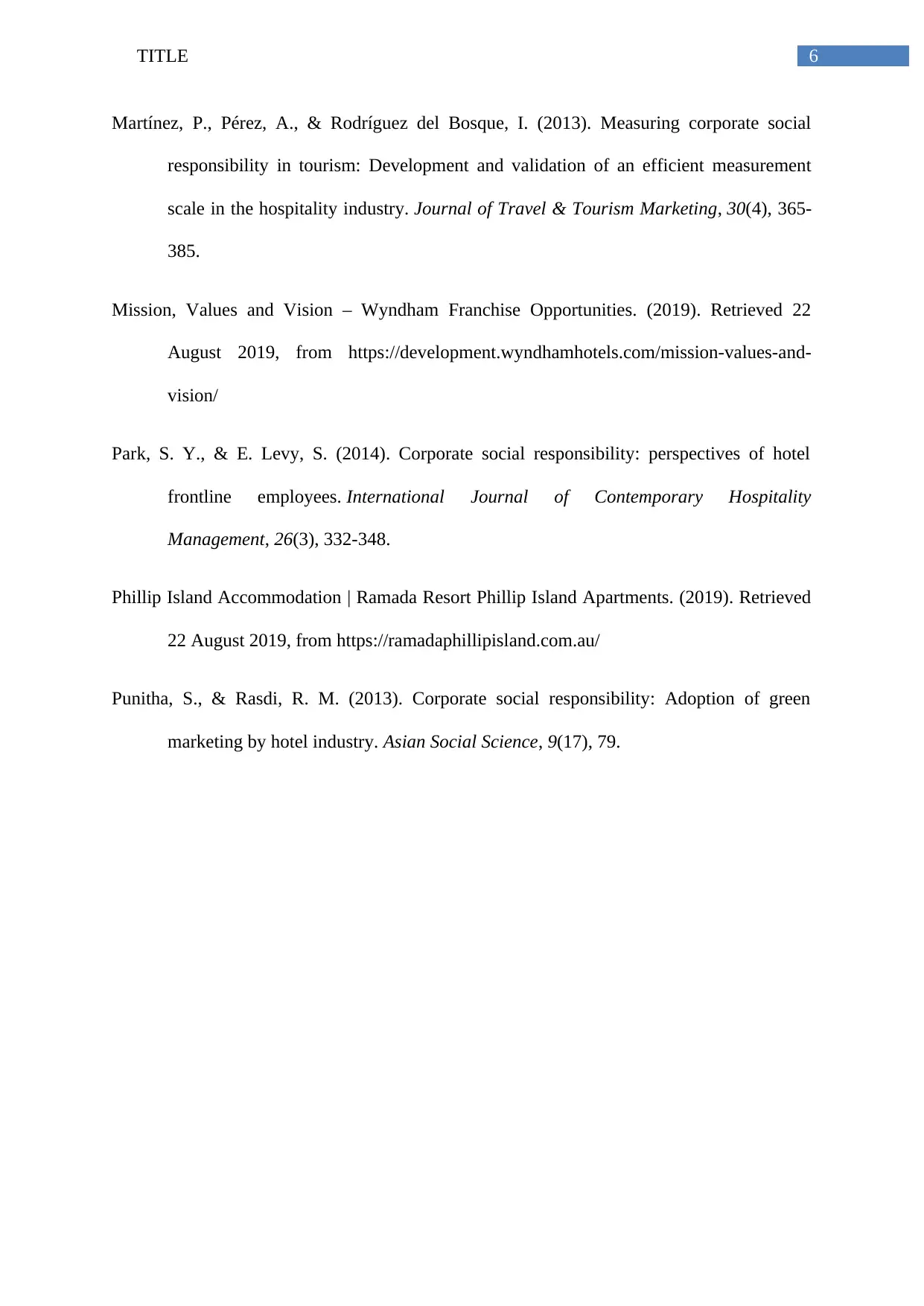
6TITLE
Martínez, P., Pérez, A., & Rodríguez del Bosque, I. (2013). Measuring corporate social
responsibility in tourism: Development and validation of an efficient measurement
scale in the hospitality industry. Journal of Travel & Tourism Marketing, 30(4), 365-
385.
Mission, Values and Vision – Wyndham Franchise Opportunities. (2019). Retrieved 22
August 2019, from https://development.wyndhamhotels.com/mission-values-and-
vision/
Park, S. Y., & E. Levy, S. (2014). Corporate social responsibility: perspectives of hotel
frontline employees. International Journal of Contemporary Hospitality
Management, 26(3), 332-348.
Phillip Island Accommodation | Ramada Resort Phillip Island Apartments. (2019). Retrieved
22 August 2019, from https://ramadaphillipisland.com.au/
Punitha, S., & Rasdi, R. M. (2013). Corporate social responsibility: Adoption of green
marketing by hotel industry. Asian Social Science, 9(17), 79.
Martínez, P., Pérez, A., & Rodríguez del Bosque, I. (2013). Measuring corporate social
responsibility in tourism: Development and validation of an efficient measurement
scale in the hospitality industry. Journal of Travel & Tourism Marketing, 30(4), 365-
385.
Mission, Values and Vision – Wyndham Franchise Opportunities. (2019). Retrieved 22
August 2019, from https://development.wyndhamhotels.com/mission-values-and-
vision/
Park, S. Y., & E. Levy, S. (2014). Corporate social responsibility: perspectives of hotel
frontline employees. International Journal of Contemporary Hospitality
Management, 26(3), 332-348.
Phillip Island Accommodation | Ramada Resort Phillip Island Apartments. (2019). Retrieved
22 August 2019, from https://ramadaphillipisland.com.au/
Punitha, S., & Rasdi, R. M. (2013). Corporate social responsibility: Adoption of green
marketing by hotel industry. Asian Social Science, 9(17), 79.
1 out of 7
Related Documents
Your All-in-One AI-Powered Toolkit for Academic Success.
+13062052269
info@desklib.com
Available 24*7 on WhatsApp / Email
![[object Object]](/_next/static/media/star-bottom.7253800d.svg)
Unlock your academic potential
Copyright © 2020–2025 A2Z Services. All Rights Reserved. Developed and managed by ZUCOL.





